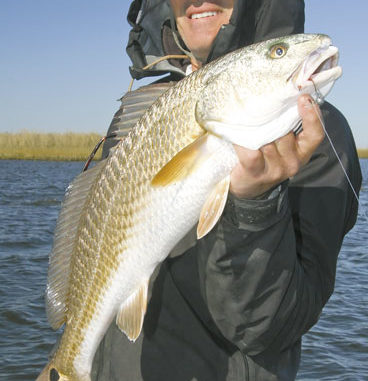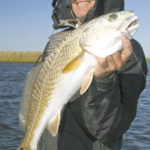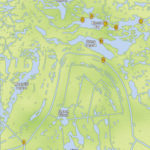
March fish can be tough to come by, but if you hit these 10 spots, we like your chances.
Behind relentless wind, the beginning of the wholesale movement of speckled trout from the inside to the outside is the second-most frequently heard excuse anglers give for struggling to catch fish during March.
The “transition,” as it’s called from one corner of coastal Louisiana to the other, creates headaches for saltwater anglers because trout that were here today are long gone tomorrow.
Simply put, the transition is when trout move from where they spent their fall and winter to where they are going to spend their spring and summer. To hear Capt. Frank Moore with Fishing With The King explain it, the trout transition is all about water temperature and bait.
“Trout have just come through the winter, and they’re looking to eat,” said Moore. “The shrimp start to show up and get prevalent, and as the water starts to warm up, the bait begins to move to the outside into Breton Sound. All the trout are doing is following the bait.”
Moore fishes out of Shell Beach in St. Bernard Parish, and he’s battled wits with the fish, the water and the weather for 50 years. He also fishes more days a week than most of us work, and that keeps him in tune with exactly what the fish are doing on an almost daily basis.
He says the key to finding transition trout is knowing a lot of spots that will act as stopping points that congregate bait and trout as they make their way out. The great thing about these kinds of spots is that the “here today and gone tomorrow” frustration of fishing during March is countered by the fact that more fish move in as others move out.
“Take the Biloxi Marsh for example,” Moore said. “Trout have been inside that marsh all winter long in places like Muscle Bay. As they start to move out, they’ll push through all the connecting bayous and bays that lead to the outside.
“From Muscle Bay, they’ll hit Crooked Bayou and out to Lake Eugenie, or they’ll move through Mack’s Pass, Stump Lagoon and into Bayou La Loutre.”
The key things any stopping point for bait and trout should have are lots of moving water, a deep-to-shallow water dynamic and lots of oyster shells. Throughout his 50 years on the water, Moore has identified hundreds of these kinds of areas. Here are 10 of his favorites around Muscle Bay.
• No. 1: St. Malo and Bayou La Loutre Intersection
(N29 50 18.74 x W89 32 50.67)
On his way to Muscle Bay, Moore can’t resist stopping at the intersection of Bayous St. Malo and La Loutre, especially since the damming of the Mississippi River Gulf Outlet was completed. He figures all the fish that used to move out through the MRGO now move through this intersection, whether they keep going down La Loutre or turn to go through Halfmoon Bay.
“There’s a lot of deep water here, and you’ve got the trees behind you to block the wind,” Moore said. “Last year, there were shrimp all over in this turn. I mean, every time you came by, there was something going on.”
Moore likes to fish the southwest corner immediately to the right as you approach the intersection. He positions his boat inside the bend where the water sweeps around this point, and casts back toward La Loutre, but he will adjust his position based on whatever the wind and tide are doing.
“This is mainly a trout spot,” Moore said. “They’ll be about 12 to 16 inches during March. I fish with plastics like the Bayou Chubs, but beetles will work too. Fish bite mainly under a cork here, but it all depends on the water temperature. If it’s cold, fish on bottom, and if it’s warm go with the cork.”
• No. 2: Mouth of Stump Lagoon to Isaac’s Ditch
(N29 52 59.20 x W89 29 56.98)
Trout like this spot during the winter because of the deep water out in the middle of Bayou La Loutre, but they really start moving through en masse once the transition begins.
Moore starts at the mouth of Stump Lagoon, but he definitely doesn’t stay there.
“Fish the entire stretch,” he insisted. “Sometimes you can hit them pretty good right here. A lot of times I just drift the lee shore with the wind to my back and cast toward the middle of the bayou, and I’ll stick up with my Power Pole if I get a bite or two.”
Moore likes the cork here, but he sets it deeper than normal because of the deep water in the middle of the bayou. He sets it about 4 or 5 feet deep, and rigs up with some of the smaller plastics like the new 2-inch Berkley Gulp shrimp.
“Sometimes they get up on the ledges on either side to sun themselves,” Moore added. “When they do that, you can set your cork back to the typical 18 to 24 inches. You could also bump the ledge with a soft plastic if they’re in the shallow water.”
• No. 3: Mack’s Pass
(N29 53 34.00 x W89 29 58.17)
Any trout leaving Muscle Bay and heading out through Stump Lagoon and Bayou La Loutre will move through this narrow and short pass. Other than the numbers of trout that move through here, the most interesting thing about Mack’s Pass is getting to it.
“There’s a reason Stump Lagoon is called Stump Lagoon,” Moore said. “You’ve got to be careful of the stumps, so I run about 30 to 40 yards off the shoreline to the west until I see the pass. Then I cut across without slowing down to keep from getting stuck.”
The pass has some good 5- to 6-foot water, and Moore says it will be stacked with bait during March. Although the pass is primarily a trout spot, Moore said redfish like to patrol the surrounding shoreline of Stump Lagoon.
“I don’t change things up too much because I don’t think I should try to fix something that isn’t broken,” he said. “Try your plastics under a cork, or bump the bottom in this pass. If you want to look for redfish, go with a dead shrimp under a cork.”
• No. 4: Crooked Bayou
(N29 54 12.83 x W89 28 33.02)
The opening of Crooked Bayou coming from Muscle Bay can’t help but stack up with every trout moving out through Lake Eugenie. The entire bayou, which acts as a major outlet, has the requisite deep water and shell bottom.
“I like to anchor about 100 yards off the point to your left as you enter Crooked Bayou,” said Moore, “but you could also anchor right on the point. It all depends on the wind. I keep it at my back, so I’ll move around so I can cast with the wind.”
Because of the deeper water in the bayou, Moore uses the same cork and soft-plastic rig he uses out in the stretch from the mouth of Stump Lagoon to Isaacs Ditch. In the unusual event that the trout don’t eat his plastic, Moore hooks on a live cocaho.
“You could also Carolina rig a minnow here,” Moore said. “You get a lot of those 12- to 16-inch trout here, but I always say that any fish that makes the party this time of year is a good fish.”
• No. 5: Muscle Bay Thoroughfare
(N29 54 0.22 x W89 29 23.98)
Like the mouth of Crooked Bayou, any trout leaving Muscle Bay will move through this wide pass. It’s a little unique in that it has 6 to 8 feet of water to your right as you work your way into Muscle Bay, but it shallows up on your left.
“This spot concentrates more than trout just from Muscle Bay,” Moore said. “Think about all the fish back in Pete’s Lagoon and all of the other bays and ponds between here and Lake Borgne — they’re going to filter through here.”
The entire pass is loaded with shells on the bottom, and Moore likes to set up and drift one side then the other basing his first drift on whether he wants to hit the deep side if it’s cold or the shallow side if it’s warm.
“In March, the edge of the deep water is important,” he said. “As it warms up later in the day, trout move out of the deep water and up on the shallow flats to find that comfort zone that’s a perfect combination of temperature and bait. You can fish your corks and bump the bottom whatever kind of tide you’ve got.”
• No. 6: Muscle Bay Hole
(N29 54 6.88 x W89 29 52.56)
As Moore moves into Muscle Bay, he likes to anchor right in the middle of this hole and work both sides from top to bottom. The middle of the opening runs 5 to 6 feet deep, but it shallows considerably the closer you get to the bank.
“You could throw a topwater in here, but you would have to fish it off the ledges,” Moore said. “I prefer to fish the deeper part with a Carolina-rigged cocaho minnow. I’ve killed them here with the minnow on bottom over the years.”
Although Moore prefers a rising tide here, he pointed out that it really didn’t matter as long as the water was moving. If he’s fishing trout, he likes to anchor off the points and throw out into deep water.
“But if you’re after redfish, you got to get on the bank and fish a dead shrimp under a cork,” he said. “And make sure to fish the points. There are a couple on either side that the reds stack up on when the water is moving past them.”
• No. 7: Pass to Pete’s Lagoon
(N29 54 19.39 x W89 30 22.87)
This is the pass to take to get back into Pete’s Lagoon, and Moore says this spot really turns on when the tide is falling. Water pulls out of Pete’s and rolls past the point to your left as you face the mouth of the pass. There is also a PVC-marked ditch that runs from this point to the far bank to the southeast.
“When they first put it in, they didn’t mark it and people ran aground,” Moore said. “Katrina kind of knocked the top off the edges of it, and it’s pretty deep in the middle. I like to get behind the point of the pass when the water is coming out and throw back to the pass because trout stack up on top of the ledge when the water’s pulling out.”
Moore says that while all of these spots replenish trout throughout the spring, this is the kind of spot that really loads up time and time again because it is a major pass between two open bays through which the fish have to move.
“Trout could be anywhere here,” he said. “Don’t just fish the point. Trout get where the bait is, so pay attention to any signs of bait. Stick with your cork here, and try your plastics and minnows. And this is not a spot for fishing on a rising tide.”
• No. 8: Pond Pocket
(N29 54 16.29 x W89 30 45.51)
If you’re looking for reds, Moore says they stack up in the mouth of the drain in the back of this pocket. There are a few ponds behind this pocket that drain during a falling tide, and the redfish like to stack up to your left as you face the pocket, and eat any bait coming out.
“It’s not a very big spot, so you can drop your anchor or stick your Power Pole and fish the entire spot from one position,” Moore said. “I like it best when there’s a little wind at my back and blowing into the pocket. That kind of mixes everything up and confuses the bait, and the reds know it.”
Moore likes to fish dead shrimp under a cork as close to the bank as he can get it. Because he believes the redfish patrol the bank while smelling their way to something to eat, he tries to leave his cork in the same place as long as possible.
“You can also catch some trout here, but they’re more out in the middle in the deeper water and toward the bank to your right,” Moore said. “And there’s nothing special about it — cocahoes or plastics under your cork.”
• No. 9: Pete’s Three Way
(N29 54 57.88 x W89 30 46.24)
As you make your way through the pass to Pete’s Lagoon, you will dead end at a straight canal. Turn left to get to Pete’s Lagoon, but make sure to stop and fish the area around the intersection before you do. Surrounding bays and ponds drain through this spot, and the combination of great water movement and deep water make it an excellent March spot.
“You can never tell where the trout will be here, so you’ve got to fish the whole spot,” Moore said. “I like to turn to the right at the intersection and jam my boat up on the bank on the point. From here, I can fish the far cut to my right and the intersection just by moving around a little bit in my boat.”
Moore explained that this is more of a feast-or-famine kind of spot than the others, and he wouldn’t give it much more than 10 minutes before moving back into Pete’s Lagoon. If he sees something interesting like bait flicking around or some birds feeding, he’ll stick around a little longer, but not much.
“Because of the deeper water and the amount of water movement through here, you could try a Carolina-rigged cocaho,” Moore said. “Other than that, stick with your corks and plastics on the bottom.”
• No. 10: Pete’s Lagoon
(N29 54 53.55 x W89 31 6.08)
Pete’s offers a little more variety than Moore’s other spots because it’s more of an open pond than it is a bottleneck, bayou or pocket. As you enter into the lagoon, Moore says the deepest water will be to your left and the shallow flat will be to your right.
“This is one of my favorite spots to fish in this area because I’ve just caught so many here,” Moore said. “And it’s good no matter if it’s cold out or if it’s warm because of the deep and shallow water combination.”
If it’s cold or early in the morning, Moore likes to go in drifting the left side toward a couple of islands in the distance. After a warm spell and later in the afternoon, he adjusts and drifts the shallow flat to the left.
“You can do topwaters and some of the suspending baits in here,” Moore said, “but I’m sticking with my cork. On the deep side, you might be able to bump the bottom with a Bayou Chub. Open areas like this are more for trout, but you can catch some redfish on the points to your left and around the ponds straight in front of you.”
Contact Capt. Frank Moore at 504-887-4960 or 504-881-9966.




